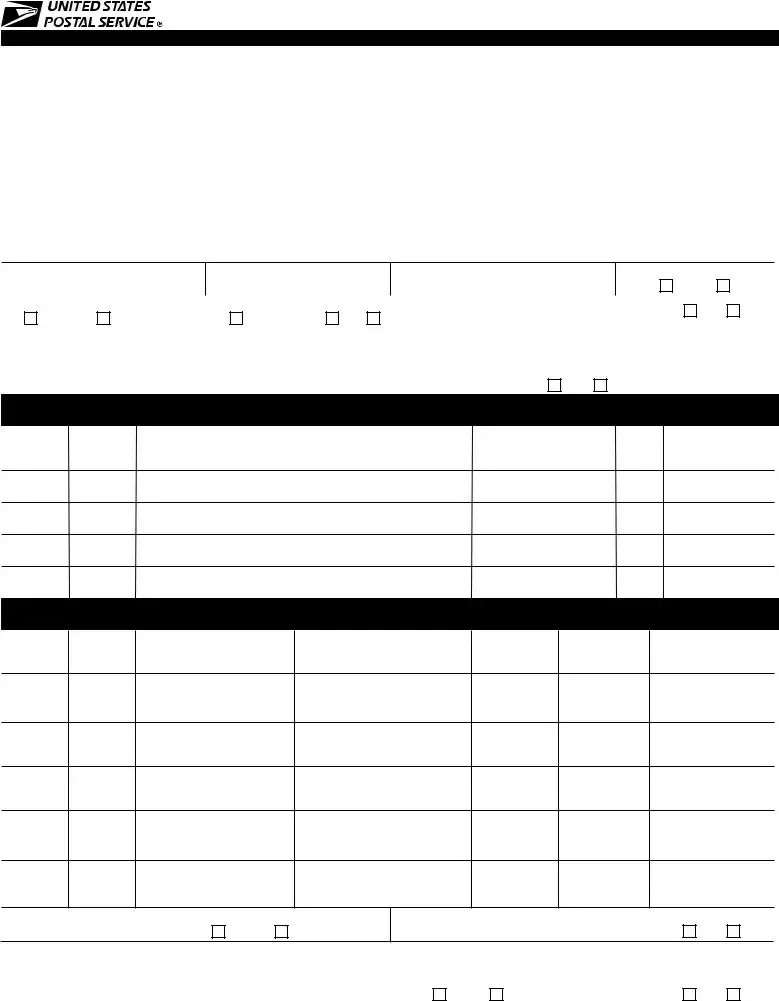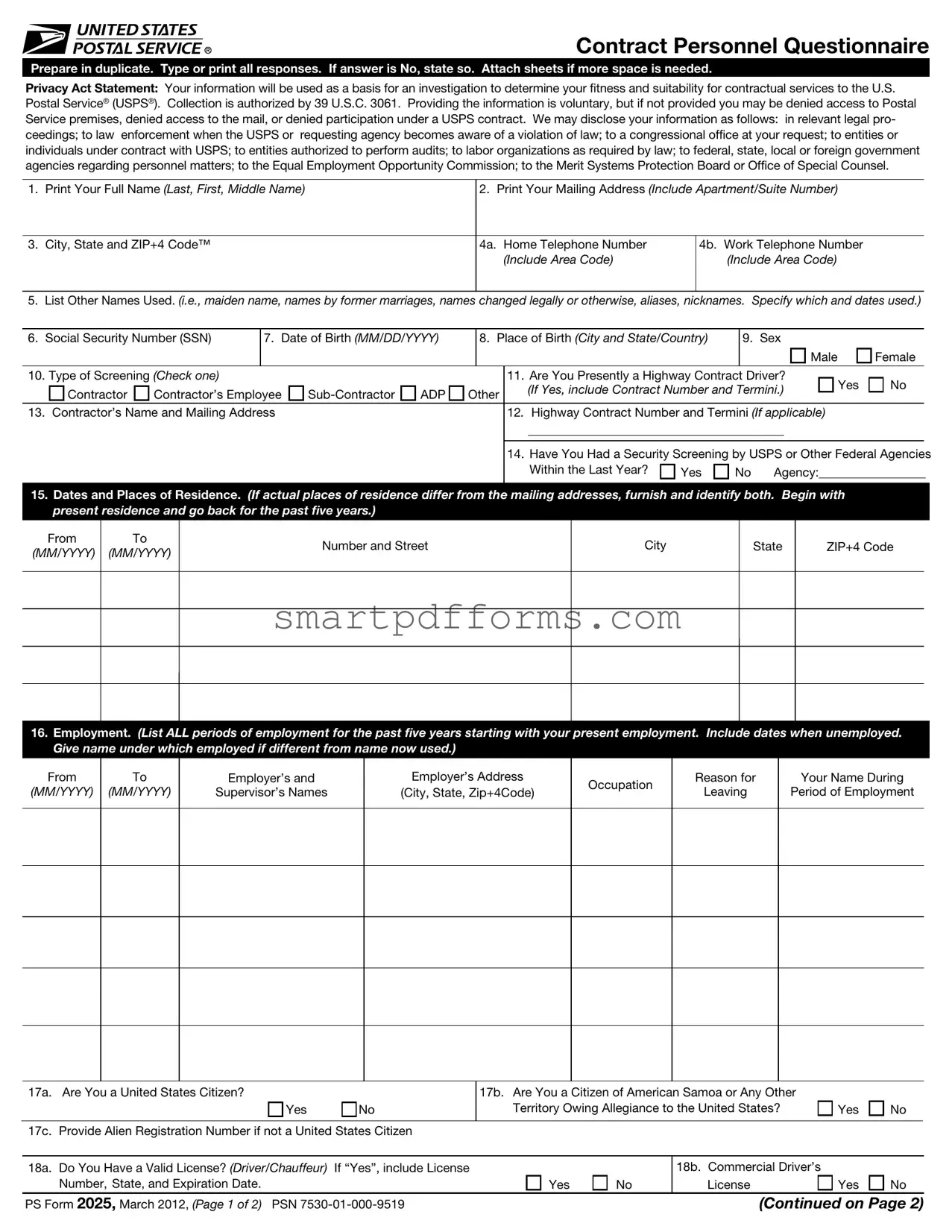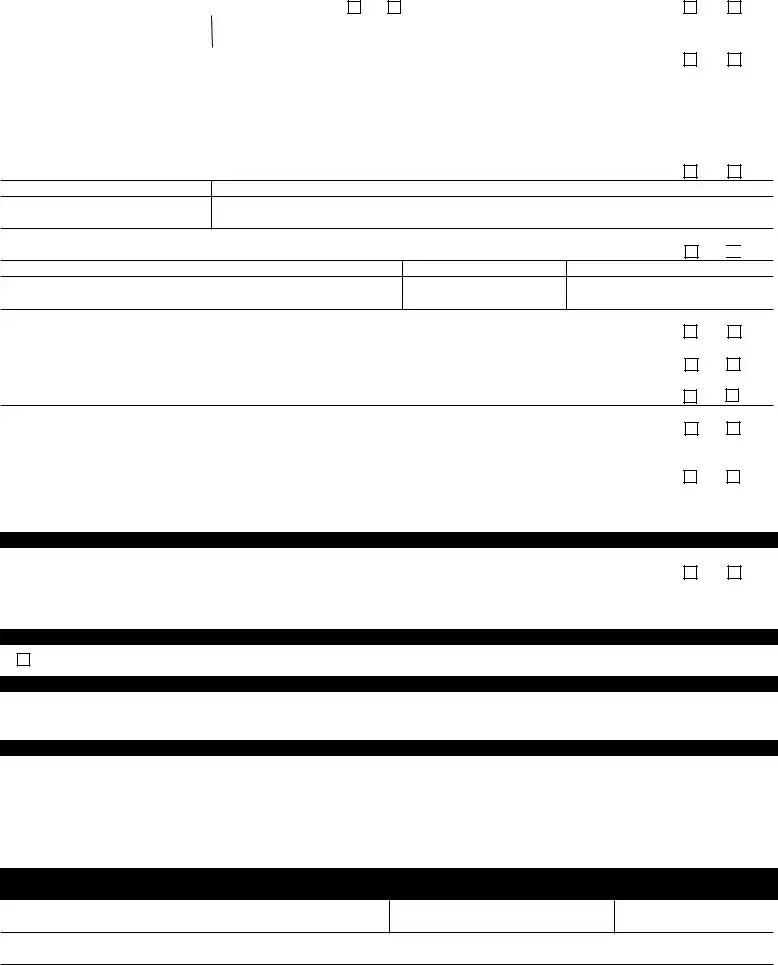
Contract Personnel Questionnaire
Prepare in duplicate. Type or print all responses. If answer is No, state so. Attach sheets if more space is needed.
Privacy Act Statement: Your information will be used as a basis for an investigation to determine your fitness and suitability for contractual services to the U.S. Postal Service® (USPS®). Collection is authorized by 39 U.S.C. 3061. Providing the information is voluntary, but if not provided you may be denied access to Postal Service premises, denied access to the mail, or denied participation under a USPS contract. We may disclose your information as follows: in relevant legal pro- ceedings; to law enforcement when the USPS or requesting agency becomes aware of a violation of law; to a congressional office at your request; to entities or individuals under contract with USPS; to entities authorized to perform audits; to labor organizations as required by law; to federal, state, local or foreign government agencies regarding personnel matters; to the Equal Employment Opportunity Commission; to the Merit Systems Protection Board or Office of Special Counsel.
1. |
Print Your Full Name (Last, First, Middle Name) |
2. Print Your Mailing Address (Include Apartment/Suite Number) |
|
|
|
|
3. |
City, State and ZIP+4 Code™ |
4a. Home Telephone Number |
4b. Work Telephone Number |
|
|
(Include Area Code) |
(Include Area Code) |
|
|
|
|
5.List Other Names Used. (i.e., maiden name, names by former marriages, names changed legally or otherwise, aliases, nicknames. Specify which and dates used.)
6. Social Security Number (SSN)
7.Date of Birth (MM/DD/YYYY)
8.Place of Birth (City and State/Country)
10. Type of Screening (Check one) |
|
|
|
11. |
Are You Presently a Highway Contract Driver? |
Yes |
No |
|
Contractor |
Contractor’s Employee |
Sub-Contractor |
ADP |
Other |
|
(If Yes, include Contract Number and Termini.) |
|
|
|
|
|
|
|
|
|
|
|
|
|
|
|
|
13. Contractor’s Name and Mailing Address |
|
|
|
12. Highway Contract Number and Termini (If applicable) |
|
|
|
|
|
|
|
|
|
|
|
|
|
|
|
|
|
|
|
|
|
|
|
|
|
|
|
|
|
|
|
|
|
|
|
14. |
Have You Had a Security Screening by USPS or Other Federal Agencies |
|
|
|
|
|
|
Within the Last Year? |
Yes |
No |
Agency: |
|
|
|
|
|
|
|
|
|
|
|
|
|
|
|
|
|
|
|
|
15.Dates and Places of Residence. (If actual places of residence differ from the mailing addresses, furnish and identify both. Begin with present residence and go back for the past five years.)
|
From |
To |
Number and Street |
City |
State |
|
(MM/YYYY) |
(MM/YYYY) |
|
|
|
|
16.Employment. (List ALL periods of employment for the past five years starting with your present employment. Include dates when unemployed. Give name under which employed if different from name now used.)
Employer’s and
Supervisor’s Names
Employer’s Address
(City, State, Zip+4Code)
Your Name During
Period of Employment
17a. Are You a United States Citizen?
Yes
17b. Are You a Citizen of American Samoa or Any Other Territory Owing Allegiance to the United States?
17c. |
Provide Alien Registration Number if not a United States Citizen |
|
|
|
|
|
|
|
|
|
|
|
|
|
18a. |
Do You Have a Valid License? (Driver/Chauffeur) If “Yes”, include License |
|
|
18b. |
Commercial Driver’s |
|
|
Number, State, and Expiration Date. |
Yes |
No |
|
License |
Yes |
No |
PS Form 2025, March 2012, (Page 1 of 2) PSN 7530-01-000-9519 |
|
|
|
|
(Continued on Page 2) |
Type of Discharge
Charge
19. |
Your Selective |
|
19a. Are you a male born after December |
|
19b. |
Have you registered with the Selective Service System? |
If “Yes”, |
|
31, 1959? |
If “No”, go to 20a. If Yes, |
|
|
provide your registration number. If “No”, |
|
|
|
Service Record |
|
|
|
|
|
|
|
go to 19b. |
Yes |
No |
|
show the reason for your legal exemption. |
Yes |
No |
|
|
|
|
19c. |
Registration Number |
19d. Legal Exemption Explanation |
|
|
|
|
|
|
|
|
|
|
|
|
|
|
20a. |
Military Service (Past or Present). (If Yes, complete Items 20b, 20c, 20d, 20e, and 20f.) |
|
|
Yes |
No |
|
|
|
|
|
|
|
|
20b. Dates of Service (MM/YYYY) |
20c. Branch of Service (Army, Navy, Air Force, |
|
20d. Serial Number (If none, provide Grade or Rating at |
Marines, etc.) |
|
|
|
time of separation) |
|
|
|
|
|
|
|
|
|
|
|
To |
|
From |
|
|
|
|
|
|
|
|
|
|
|
|
|
|
|
20e. Were You Discharged from the Military Service Under Honorable Conditions? (If your discharge was changed to “honorable” or |
|
|
“general” by a Discharge Review Board, answer “Yes”. If you received a clemency discharge, answer “No”.) If No, enter the date |
|
|
and type of discharge you received in the blocks below. |
|
|
|
|
Yes |
No |
|
|
|
|
|
|
|
|
|
Discharge Date (MM/YYYY)
20f. While in Military Service, Were You Ever Convicted by Court Martial?
Court Martial Date (MM/DD/YYYY) |
Place (City and State/Country) |
|
|
Yes 
 No
No
Disposition
21a. |
Have You Ever Been Convicted of, or Forfeited Collateral, for Any Felony/Misdemeanor Violation (Except Traffic Violations)? |
|
|
|
(Generally, a felony is defined as any violation of law punishable by imprisonment of one year or longer.) |
Yes |
No |
21b. During the Last 10 Years Have You Forfeited Collateral, Been Convicted, Been Imprisoned, Been on Probation, or Been |
|
|
|
on Parole for any Violation of Law? (Do not include violations reported in question 21a.) |
Yes |
No |
21c. |
Have You Ever Been Convicted of, or Forfeited Collateral for Any Assaults, Firearms or Explosives Violations? |
|
|
21d. Are You Now Under Charges for Any Violation of Law?
|
|
|
|
|
Yes |
No |
If any answers to 21a - 21d are “Yes”, provide date, place, court location, charge, and disposition on an attached sheet. |
|
|
|
21e. Are You Delinquent on any Federal Debt? (Include delinquencies arising from Federal taxes, overpayment of benefits, or other |
|
|
|
debts to theU.S. Government plus defaults on Federally guaranteed or insured loans such as student and home mortgage loans.) |
Yes |
No |
Date (MM/YYYY) |
Place (City and State) |
Court |
Charge |
|
Action Taken |
|
|
|
|
|
|
|
|
|
|
If necessary, attach additional sheets.
22.In the Past 5 years, Have You Been Convicted of any Traffic Violations (Other Than Parking) or Currently Have Charges
Pending? (If Yes, complete information below.) |
|
|
Yes |
No |
Date (MM/YYYY) |
Place (City and State) |
Court |
Charge |
Action Taken |
|
|
|
|
|
|
|
If necessary, attach additional sheets.
Check Here if Your Driver’s Abstract from Department of Motor Vehicles is Attached.
Warning
Review this form carefully to ensure you have answered all questions fully and correctly. Failure to answer all questions may result in your being denied access to mail and/or Postal Service premises. A fine not to exceed $250,000 or imprisonment of not more than five years or both is provided by law (18 U.S.C. 1001) for making a false statement or concealing any material fact on this Questionnaire.
Certification
I certify that the statements made by me on this questionnaire are true, complete, and correct to the best of my knowledge and belief, and are made in good faith.
Applicant’s Signature |
Date Signed (MM/DD/YYYY) |
|
|
I attest I have advised the Applicant to truthfully complete this Questionnaire, and the Applicant has passed the Drug Screening Test (If applicable, provide documentation).
Contractor’s Signature (Sign and print name) |
Telephone Number (Include area code) |
Date Signed (MM/DD/YYYY) |
|
|
|
For Use of Postal Service Official Responsible for Reviewing for Completeness and Legibility. (See Administrative Support Manual 272.23, Contractor
Clearance, for complete instructions.)
USPS Official Signature (Sign and print name)
Telephone Number (Include Area Code)
Organization, City, State, and ZIP+4 Code
PS Form 2025, March 2012 (Page 2 of 2)




 No
No